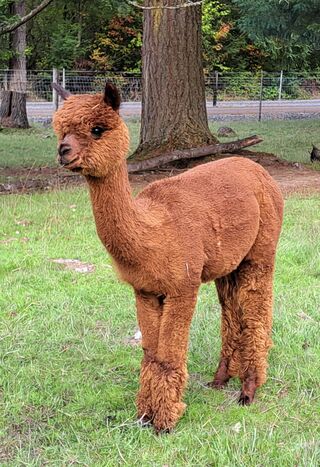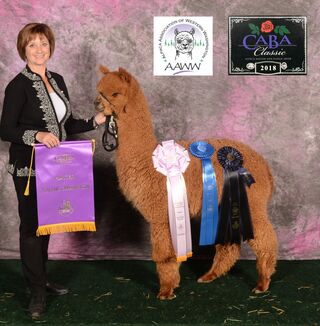Pedigree Productivity
By Laura Coussens - Kissin’ Coussens Alpacas
When we think about making a large investment of any kind, one thing we do beforehand is gather information to assess possible returns as well as risks. Well, the same should be true with alpacas. One important thing we can do to determine the amount of risk involved when purchasing an alpaca is to research the productivity of its lineage. When selecting prospective alpacas, in addition to price, quality of fleece, conformation and overall soundness, most of us also look at pedigrees for names we recognize. We also visit as many alpaca farms as possible. Then, when we get back home, we are very fortunate to have many informative web sites where we can look at alpaca photos from across the country. We can then look for an acceptable level of consistency in the phenotypes (the looks) of alpacas in a particular lineage. A picture can speak a thousand words, but to maximize production, quality must be more than fleece deep. So, after all the usual research that most alpaca breeders do, what do we really know about a pedigree’s true quality and productivity and hence what we can expect from it?
To assess pedigree productivity, we can research the ARI (Alpaca Registry, Inc.) database and document the number of registered offspring for each ancestor. I use a copy of the certificate, or chart the lineage and inquire on each animal in the entire pedigree noting birth dates and the number and colors of offspring and their birth dates, etc. What I’m hoping to find is very consistent production. I once researched an alpaca with a full pedigree on its certificate and every female on it had 8-10 crias to her credit. Think about that for a minute. Alpacas living on different farms, in different environments, with close to a perfect production record…wow!
However, I have also found lineages with very low productivity for the ages of the animals, which raises concern and the possible need for further investigation. There are many reasons why an alpaca may have a spotty production record. Not all breeders register their animals in a timely manner and not all pet quality males are registered. This skews the male to female ratios and leaves large gaps of needed data for accurate color inheritance and herd population growth as well as production statistics. Then, there are quality herdsires, some previously owned by larger farms, now owned by smaller farms doing a limited number of breedings each year. Females sometimes do not carry to term, become ill, or are given a rest. There are also herdsires, and dams that have sparse track records because their offspring have manifested serious defects on one or more occasions. Unfortunately, sometimes these animals are sold and put back into production instead of being neutered or permanently culled and so you will see gaps in production when the viable offspring are registered. For both machos and hembras, I print out their listing of offspring from the ARI database and then inquire on each offspring, noting the number of their crias. What I hope to find is consistent production for both female and male progeny. If I find a higher than expected number of offspring from many of the alpaca’s sons, then that is all the better!
When necessary, any ARI member can make a request to the ARI office for the contact information of an owner of a registered alpaca. Then, simply ask what that breeder or owner knows about the alpaca in question and its lineage. We are fortunate now to have many alpacas with extensive pedigrees. We need to remember that the alpaca at the top of the certificate carries with it a random selection of genetics from all of its ancestors. And, as animal breeders, we have many responsibilities. Achieving overall improvement of the species and the prosperity of our industry requires setting many goals. We construct these goals based on knowledge, experience and our personal desires. We can debate things such as phenotype and whether an alpaca should produce 10 or 20 pounds of fleece annually, but there is not much room for debating the need for consistent production of sound alpacas. Researching pedigree productivity is time-consuming, but it is time well spent. It will help ensure that the level of risk for your alpaca investment is acceptable for your particular situation. Happy researching, happy breeding and happy criations!
May 23, 2011

